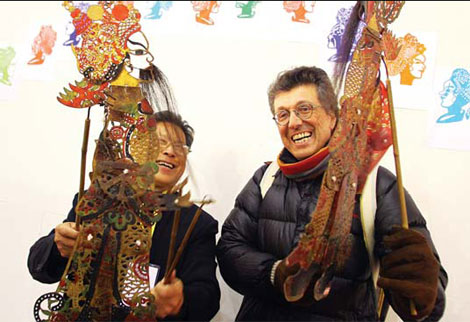
Spanish visitor Sangit Prats learns shadow puppetary with Liu Nianhua, an intangible heritage inheritor.
Quzhi, a master of thangka (Tibetan Buddhist scroll paintings), recently opened a thangka academy in his hometown Wutun, Qinghai province, that teaches 100 apprentices. A large-scale thangka work Quzhi and his students finished that was displayed at the exhibition sold for 600,000 yuan.
"The productive protection of intangible cultural heritage will not only increase enthusiasm for carrying on traditional culture but also will stimulate cultural consumption," Cai says.
The exhibition was admission-free and attracted visitors from home and abroad.
"It's a rare opportunity for us to see so many Chinese arts and culture in one place, and presented in such a nice way that enables us to meet the artists and see how colorful and diverse China is," says Gudrun Hardiman-Pollross, cultural counselor of the Austrian Embassy in Beijing.
Botswana's ambassador to China, Sasara Chasala George, says the drum and dance performances remind him of Africa. He's especially interested in the ways Chinese craftspeople incorporate traditional culture in their work.
"I like the way that Chinese people have commercialized traditional art," he says.
"Your art can be performed onstage and travel. It's not art for the sake of art. We haven't reached this stage in our country, and I hope we can learn from China."

Copyright ©1999-2011 Chinanews.com. All rights reserved.
Reproduction in whole or in part without permission is prohibited.